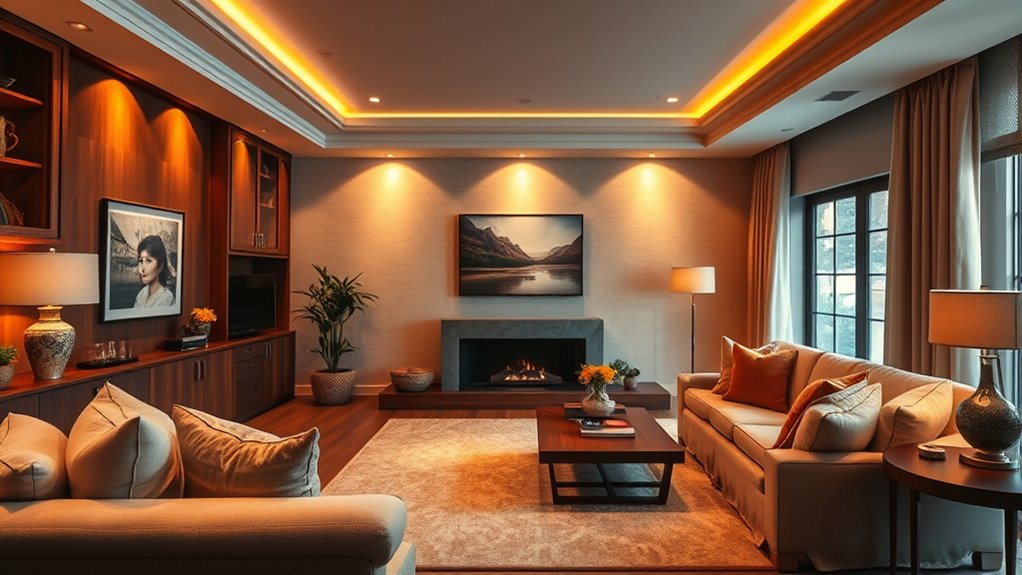To decorate with light temperature and CRI, choose warm tones (2700K–3000K) for cozy spaces like living rooms, and cool tones (above 5000K) for energizing areas like kitchens or workspaces. Opt for high CRI bulbs (close to 100) to guarantee true, vibrant colors, especially in art or display areas. Balancing these factors helps you create inviting, functional environments. Keep exploring how these elements can transform your decor and enhance your space’s mood and appearance.
Key Takeaways
- Choose warm light (2700K–3000K) for cozy, inviting spaces like living rooms and bedrooms.
- Use cool light (above 5000K) in work areas to enhance alertness and focus.
- Select high CRI (close to 100) bulbs to accurately showcase colors in art, retail, and kitchen spaces.
- Combine appropriate color temperature with high CRI for optimal ambiance and true color rendering.
- Match lighting choices to desired mood—warm for relaxation, cool for energy and clarity.

Have you ever wondered how the color and quality of light can transform a space? The way light interacts with your environment isn’t just about brightness; it’s about the mood, atmosphere, and even how colors appear. Two key factors that influence this are color temperature and the color rendering index (CRI). Understanding these elements allows you to craft spaces that feel inviting, vibrant, or calming, depending on your goals.
Color temperature, measured in Kelvin (K), defines whether a light appears warm, neutral, or cool. Warm lighting, around 2700K to 3000K, casts a cozy, yellowish glow that’s perfect for living rooms and bedrooms, creating a relaxed and intimate vibe. On the other hand, cool lighting, above 5000K, emits a bluish tone that energizes a space, making it ideal for work environments or kitchens where clarity and focus are essential. As you choose light bulbs or fixtures, consider the atmosphere you want to establish. For instance, a restaurant aiming for a romantic ambiance might opt for warmer tones, while a home office benefits from cooler, more alerting light.
Warm lighting (2700K–3000K) creates cozy, inviting spaces, while cool lighting (above 5000K) energizes and sharpens focus.
But color temperature isn’t the whole story. The color rendering index, or CRI, measures how accurately a light source reveals the true colors of objects compared to natural daylight. A high CRI—close to 100—means that colors will appear vibrant and true, making this significant in spaces where color accuracy matters, like art studios, boutiques, or kitchens. If your goal is to make colors pop or to see details clearly, prioritize lighting with a high CRI. Conversely, lower CRI lights might be sufficient for ambient or decorative purposes where color fidelity isn’t as critical.
When decorating with light, it’s essential to balance both these factors. For example, in a gallery or craft room, you’ll want a high CRI light with a neutral or slightly warm temperature to showcase artwork’s true colors without harsh shadows or distortions. In a cozy living room, a warm color temperature paired with a decent CRI creates an inviting atmosphere that feels natural and comfortable. If you’re setting up a workspace, opt for cool tones with high CRI bulbs to enhance focus and ensure you see colors and details accurately. Additionally, being aware of lighting standards can help you select the right lighting for different applications to optimize visual comfort and color perception.
Frequently Asked Questions
How Does Light Temperature Affect Mood and Productivity?
You’ll find that light temperature markedly influences your mood and productivity by shaping the ambient atmosphere. Cooler light (around 5000K) promotes alertness and focus, aligning with color psychology that boosts energy. Warmer light (around 2700K) creates a relaxing environment, reducing stress. By adjusting light temperature, you can craft a space that encourages either activity or calmness, helping you stay motivated and balanced throughout your day.
What Are the Best CRI Levels for Art Display?
Ever wonder how your art truly pops? You should aim for a CRI of 90 or above for art display. High CRI levels guarantee excellent color rendering, making every hue vibrant and true to life. This enhances artistic detail, allowing viewers to appreciate your work’s depth and nuance. Don’t settle for dull or distorted colors—choose lighting that highlights your art’s full beauty and brilliance.
Can Different Light Temperatures Be Used in One Room Effectively?
Yes, you can use different light temperatures in one room effectively by focusing on color consistency and fixture placement. To avoid mismatched tones, choose fixtures with similar CRI levels and plan strategic placement to highlight specific areas. This approach creates a balanced look, enhances ambiance, and prevents visual confusion. Properly mixing warm and cool lights can add depth and interest, making your space more dynamic and inviting.
How Do I Choose Lighting for Outdoor Spaces?
You should select landscape lighting that enhances your outdoor ambiance and suits your space’s function. Opt for warm tones to create a cozy feel and cooler lights for a modern look. Focus on layered lighting — like pathway, spot, and ambient lights — to add depth and safety. Consider weather-resistant fixtures and energy-efficient options. Properly placed lights will highlight your landscape features and make your outdoor space inviting and safe after dark.
What Are the Energy Implications of Different CRI and Temperature Choices?
Choosing cooler color temperatures and higher CRI can cause increased energy use, impacting efficiency and bulb lifespan. Warm tones typically consume less energy and last longer, so you save on bills and replacements. Bright, high-CRI lighting enhances visuals but may demand more power. To balance beauty and budget, opt for energy-efficient bulbs with suitable color temperatures. This way, you enjoy vibrant spaces without wasting energy or shortening bulb longevity.
Conclusion
By choosing the right light temperature and CRI, you can transform your space into a breathtaking sanctuary that feels as warm and inviting as a sunlit meadow. Don’t underestimate the power of lighting—it’s like painting with the colors of the sky at sunset. When you master these elements, your decor will shine brighter than a thousand stars, creating an ambiance that leaves everyone in awe. So, light up your world and watch your space come alive!









